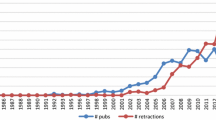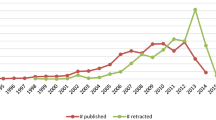Abstract
In 2009, Scott S. Reuben was convicted of fabricating data, which lead to 25 of his publications being retracted. Although it is clear that the perpetuation of retracted articles negatively effects the appraisal of evidence, the extent to which retracted literature is cited had not previously been investigated. In this study, to better understand the perpetuation of discredited research, we examine the number of citations of Reuben’s articles within 5 years of their retraction. Citations of Reuben’s retracted articles were assessed using the Web of Science Core Collection (Thomson Reuters, NY). All citing articles were screened to discriminate between articles in which Reuben’s work was quoted as retracted, and articles in which his data was wrongly cited without any note of the retraction status. Twenty of Reuben’s publications had been cited 274 times between 2009 and 1024. In 2014, 45 % of the retracted articles had been cited at least once. In only 25.8 % of citing articles was it clearly stated that Reuben’s work had been retracted. Annual citations decreased from 108 in 2009 to 18 in 2014; however, the percentage of publications correctly indicating the retraction status also declined. The percentage of citations in top-25 %-journals, as well as the percentage of citations in journals from Reuben’s research area, declined sharply after 2009. Our data show that even 5 years after their retraction, nearly half of Reuben’s articles are still being quoted and the retraction status is correctly mentioned in only one quarter of the citations.

Similar content being viewed by others
References
Bornemann-Cimenti, H., & Sandner-Kiesling, A. (2014). Avoiding perpetuating fraudulent publications in addendum to Sagit M et al.: Efficacy of a single preoperative dose of pregabalin for postoperative pain after septoplasty. Journal of Craniofacial Surgery, 25(2), 717. doi:10.1097/01.scs.0000436679.89690.93.
Bornemann-Cimenti, H., & Sandner-Kiesling, A. (2015). Bringing retracted papers into focus. Clinical and Experimental Otorhinolaryngology, 8(1), 81. doi:10.3342/ceo.2015.8.1.81.
Cabbolet, M. J. (2014). Scientific misconduct: Three forms that directly harm others as the modus operandi of Mill’s tyranny of the prevailing opinion. Science and Engineering Ethics, 20(1), 41–54. doi:10.1007/s11948-013-9433-8.
Davis, P. M. (2012). The persistence of error: A study of retracted articles on the Internet and in personal libraries. Journal of the Medical Library Association, 100(3), 184–189. doi:10.3163/1536-5050.100.3.008.
Decullier, E., Huot, L., Samson, G., & Maisonneuve, H. (2013). Visibility of retractions: A cross-sectional one-year study. BMC Research Notes, 6, 238. doi:10.1186/1756-0500-6-238.
Eisenach, J. C. (2009). Data fabrication and article retraction: How not to get lost in the woods. Anesthesiology, 110(5), 955–956. doi:10.1097/ALN.0b013e3181a06bf9.
Elia, N., Wager, E., & Tramer, M. R. (2014). Fate of articles that warranted retraction due to ethical concerns: A descriptive cross-sectional study. PLoS One, 9(1), e85846. doi:10.1371/journal.pone.0085846.
Fang, F. C., Steen, R. G., & Casadevall, A. (2012). Misconduct accounts for the majority of retracted scientific publications. Proceedings of the National Academy of Sciences USA, 109(42), 17028–17033. doi:10.1073/pnas.1212247109.
Lammey, R. (2014). How to apply CrossMark and FundRef via CrossRef extensible markup language. Science Editing, 1(2), 84–90. doi:10.6087/kcse.2014.1.84.
Lelgemann, M., & Sauerland, S. (2010). Fraudulent studies, unpublished data and their effect on the development of guidelines and evidence-based recommendations. Zeitschrift fur Evidenz, Fortbildung und Qualitat im Gesundheitswesen, 104(4), 284–291.
Madlock-Brown, C. R., & Eichmann, D. (2015). The (lack of) impact of retraction on citation networks. Science and Engineering Ethics, 21(1), 127–137. doi:10.1007/s11948-014-9532-1.
Marret, E., Elia, N., Dahl, J. B., McQuay, H. J., Moiniche, S., Moore, R. A., et al. (2009). Susceptibility to fraud in systematic reviews: Lessons from the Reuben case. Anesthesiology, 111(6), 1279–1289. doi:10.1097/ALN.0b013e3181c14c3d.
Rama-Maceiras, P., Ingelmo, I. I., Fabregas, J. N., & Hernandez-Palazon, J. (2009). Fraudulent pain research: A hurt so deep nothing can alleviate it. Revista Espanola de Anestesiologia y Reanimacion, 56(6), 372–379.
Ren, T., Ding, L., & He, Z. (2014). Factors affecting chronic pain and increases of analgesic drug consumption after knee arthroplasty. Pain, 155(12), 2720–2721. doi:10.1016/j.pain.2014.08.005.
Rittner, H. L., Kranke, P., Schafer, M., Roewer, N., & Brack, A. (2009). What can we learn from the Scott Reuben case? Scientific misconduct in anaesthesiology. Anaesthesist, 58(12), 1199–1209. doi:10.1007/s00101-009-1637-6.
Samp, J. C., Schumock, G. T., & Pickard, A. S. (2012). Retracted publications in the drug literature. Pharmacotherapy, 32(7), 586–595. doi:10.1002/j.1875-9114.2012.01100.x.
Shafer, S. L. (2009). Tattered threads. Anesthesia and Analgesia, 108(5), 1361–1363. doi:10.1213/ane.0b013e3181a16846.
Steen, R. G. (2011). Retractions in the scientific literature: Is the incidence of research fraud increasing? Journal of Medical Ethics, 37(4), 249–253. doi:10.1136/jme.2010.040923.
Steen, R. G., Casadevall, A., & Fang, F. C. (2013). Why has the number of scientific retractions increased? PLoS One, 8(7), e68397. doi:10.1371/journal.pone.0068397.
Stone, L. S., German, J. P., Kitto, K. F., Fairbanks, C. A., & Wilcox, G. L. (2014). Morphine and clonidine combination therapy improves therapeutic window in mice: Synergy in antinociceptive but not in sedative or cardiovascular effects. PLoS One, 9(10), e109903. doi:10.1371/journal.pone.0109903.
Tramer, M. R. (2013). The Fujii story: A chronicle of naive disbelief. European Journal of Anaesthesiology, 30(5), 195–198. doi:10.1097/EJA.0b013e328360a0db.
Wager, E., Barbour, V., Yentis, S., & Kleinert, S. (2009). Retractions: Guidance from the Committee on Publication Ethics (COPE). Croatian Medical Journal, 50(6), 532–535.
Watkins, A. A., Johnson, T. V., Shrewsberry, A. B., Nourparvar, P., Madni, T., Watkins, C. J., et al. (2014). Ice packs reduce postoperative midline incision pain and narcotic use: A randomized controlled trial. Journal of the American College of Surgeons, 219(3), 511–517. doi:10.1016/j.jamcollsurg.2014.03.057.
Wise, J. (2013). Boldt: The great pretender. BMJ, 346, f1738. doi:10.1136/bmj.f1738.
Wright, K., & McDaid, C. (2011). Reporting of article retractions in bibliographic databases and online journals. Journal of the Medical Library Association, 99(2), 164–167. doi:10.3163/1536-5050.99.2.010.
Author information
Authors and Affiliations
Corresponding author
Ethics declarations
Conflict of interest
There are no conflicts of interest.
Funding
This project was supported by institutional funding.
Additional information
In this study we examine the number of citations of Scott S. Reuben’s articles within 5 years of their retraction.
Rights and permissions
About this article
Cite this article
Bornemann-Cimenti, H., Szilagyi, I.S. & Sandner-Kiesling, A. Perpetuation of Retracted Publications Using the Example of the Scott S. Reuben Case: Incidences, Reasons and Possible Improvements. Sci Eng Ethics 22, 1063–1072 (2016). https://doi.org/10.1007/s11948-015-9680-y
Received:
Accepted:
Published:
Issue Date:
DOI: https://doi.org/10.1007/s11948-015-9680-y




